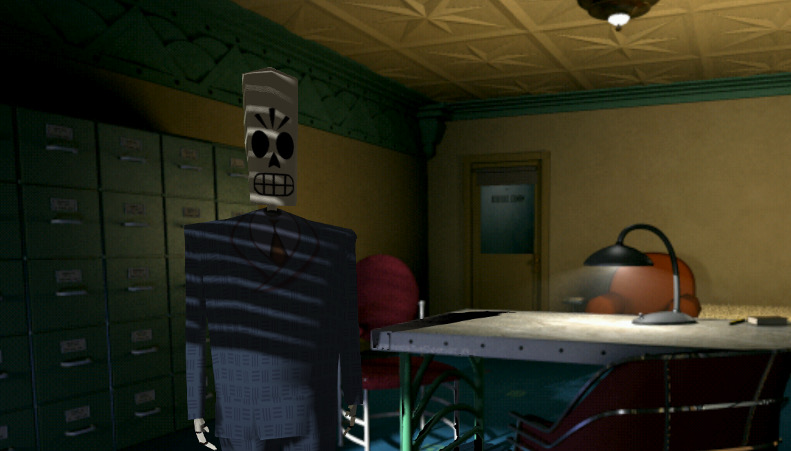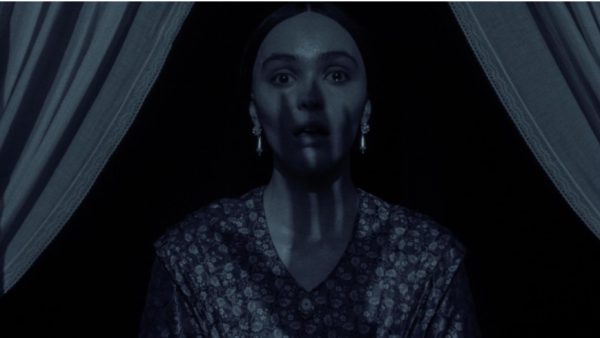EVA’S EVALS: Bringing games back from the dead with Grim Fandango: Remastered
For 15 years, Grim Fandango was stuck in purgatory.
LucasArts originally published the quirky adventure game in 1998 (to critical success but pitiful sales), and DoubleFine released a remastered version in 2015. Long story short, for much of that interim, there was no way to obtain a legitimate copy — even though Fandango was hailed as an all-time classic.
Unlike traditional media, aging games tend to be ignored by new players as the young medium rockets forward and continues to define itself (have you ever played Myst?) For me, Grim Fandango: Remastered provided a unique opportunity to play a game frozen in time. Is it really worth modern players’ attention? After all, for a long time, the entire adventure game genre — the point-and-click — was proclaimed “dead.”
Fitting, then, that critically acclaimed Remastered takes place in the land of the afterlife. It’s additions to the original include commentary, graphical upgrades, and an orchestrated soundtrack. From the onset, there are a lot of things to like. The game’s aesthetic is a mashup of film noir and Aztec tradition — the bare-bones character designs, for example, were inspired by Day of the Dead skeletons (or calacas) and the protagonist, Manny Calavera, speaks Spanglish. Also, it’s worth mentioning that the writing is excellent. While playing, I felt like I was in the middle of a animated movie.
On to mechanics. The game drops the player in with no tutorial, which is actually kind of jarring on its own considering that modern games are prone to hand-holding. Additionally, as a point-and-click beginner, Remastered showed me the art of patience that modern players have probably lost. It’s not meant to be full of blood nor explosions, and you can’t plow through the story. Every detail is important and there are no hints. I got stuck on one particular section for 15 minutes because I forgot to search a desk drawer. The reward for solving the puzzles is satisfaction. The first time I solved something without consulting a walkthrough, I felt like a genius.
Speaking of walkthroughs: Grim Fandango harkens back to a different time, when new games weren’t thrown out to the Internet like dead frogs to a class of Physiology students and relentlessly discussed and dissected. It was an era of patience and consulting the manual. Now, for better or worse, we can expect a PewDiePie supercut of a game’s highlights within 48 hours of release, and all its secrets revealed not much later. My only real link to this world was receiving a copy of Monster Rancher 2 (Temo, 1999) for the original PlayStation. I stayed up in bed that night with a flashlight and read the instruction manual cover to cover and still had no idea what I was doing. Though this lack of resources could lead to endless frustration, it also had a definite charm. Players figured the game’s little puzzles out for themselves, and every new discovery was a reward.
In the end, I would absolutely recommend picking up a copy of Grim Fandango: Remastered. The game lives up to its title as a classic, mainly due to its stellar story. Learning its history also provides tons of cool insight into game design and the industry. Play some old games. They’re still fun, and they provide a richer understanding of the medium despite (and perhaps because of) their technologic limitations. And as for the nostalgia about times gone by? It’s up to us to recreate that romantic individual experience for ourselves, even if it means avoiding Let’s Plays for a few weeks. Going in with nothing is what can make a game magical… but there are always walkthroughs available, just in case.
Now, if you don’t mind, I’ll return to my four-year journey through the land of the dead adventure game — hoping that maybe, just maybe, Remastered could spark a resurrection.
Your donation will support the student journalists of Omaha Westside High School. Your contribution will allow us to purchase equipment and cover our annual website hosting costs.







